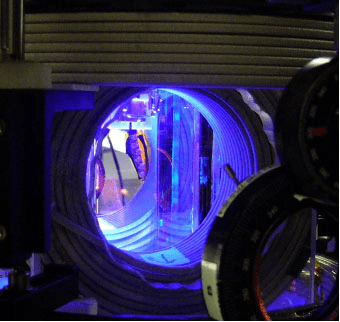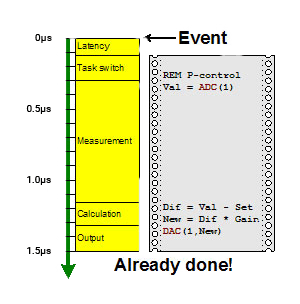ADwin-Pro-II Real-Time Data Acquisition & Control
 CAS DataLoggers provided a data acquisition and control solution for a physics professor focusing on cold atom research at a major university. They were conducting experiments producing ultracold quantum gases containing bosons and fermions. The cold atom physics experiments took place inside an ultra-high vacuum chamber with quartz windows. Researchers collected the atoms in a magneto-optical trap (MOT) which consisted of 6 circularly-polarized laser beams, one pair for each axis, and a quadrupolar magnetic field produced by two external coils with the counter-propagating current. While the MOT was on, bright purple LEDs caused light-assisted desorption of atoms from the walls of the cell so that they could be captured in the MOT.
CAS DataLoggers provided a data acquisition and control solution for a physics professor focusing on cold atom research at a major university. They were conducting experiments producing ultracold quantum gases containing bosons and fermions. The cold atom physics experiments took place inside an ultra-high vacuum chamber with quartz windows. Researchers collected the atoms in a magneto-optical trap (MOT) which consisted of 6 circularly-polarized laser beams, one pair for each axis, and a quadrupolar magnetic field produced by two external coils with the counter-propagating current. While the MOT was on, bright purple LEDs caused light-assisted desorption of atoms from the walls of the cell so that they could be captured in the MOT.
After a brief moment of optical molasses (with the lasers on but no magnetic field) which provides cooling but no trapping, the atoms were then gently transported vertically about 5 cm to within 200 μm of a magnetic chip trap by changing the shape of the magnetic field with additional energized coils. Then, the current passing through a wire on the chip, along with external coils, was used to tightly trap the atoms.
Radio frequency signals passed through another wire on the chip, which changed the shape of the trap and allowed the hottest atoms to escape, thus lowering the average energy of the ultra-cold atoms. This evaporative cooling could produce quantum degenerate gases, Bose-Einstein condensates or degenerate fermions. To undertake this incredibly demanding application, the physics department needed a modular data acquisition and control system capable of highly-accurate measurements with precise, real-time control of analog outputs to control the magnets and lasers and sequencing the various parts of the experiment plus digital outputs to switch equipment on and off or change states.
Installation
 The research team installed an ADwin-Pro-II Real-Time Data Acquisition and Control System to provide them with precise timing and deterministic control of the experiment’s processes. The ADwin system’s analog outputs were used to control the current in the magnetic coils and wires on the chip and the frequencies and amplitudes of the lasers. Additional analog outputs were programmed to step, ramp, or follow an S-shaped curve as desired to control other parts of the experimental apparatus.
The research team installed an ADwin-Pro-II Real-Time Data Acquisition and Control System to provide them with precise timing and deterministic control of the experiment’s processes. The ADwin system’s analog outputs were used to control the current in the magnetic coils and wires on the chip and the frequencies and amplitudes of the lasers. Additional analog outputs were programmed to step, ramp, or follow an S-shaped curve as desired to control other parts of the experimental apparatus.
The ADwin-Pro-ll data acquisition system came housed in a 19’ rack-mountable enclosure. The system allowed up to 480 analog inputs, digital I/Os, or a combination of these in a single chassis. Different I/O modules allowed the ADwin-Pro-ll to be configured as needed for specific experiments. Modular plug-in boards supported analog and digital I/Os, counter/timers, PWM signals, thermocouples, and various serial communication interfaces for equipment control. Communication to a host PC for configuration, visualization, and data recording is via a 100 Mbps Ethernet interface. The ADwin-Pro-II’s high-performance 1 GHz ZYNQ processor with its own local memory handled real-time data acquisition, control of outputs, and online processing of data. Its event-driven architecture allowed in-line processing of each measurement immediately after each acquisition.
Using ADbasic, a simple yet full-featured programming tool with an integrated IDE, the Pro-II’s analog channels provided a way to precisely control many devices involved in the experiment. The digital channels were used to open shutters, trigger frequency sources, flip the polarity of current sources, and trigger cameras. Several digital channels were also used to serially program frequency sources and pattern generation outputs.
Usage
Every aspect of this experiment required the precise control provided by the Pro-ll system. Voltage-controlled acousto-optical modulators altered the frequency and amplitude of the laser light, while seven external coils as well as wires on the chip created the magnetic field. The way these magnetic fields switched on and off was important to maintain the temperature of the cloud. The team used voltage-controlled power supplies to control the current through these coils and wires. Other equipment including radio and microwave frequency sources, shutters, and cameras required well-timed triggers.
For some cold atom physics experiments, the researchers chose to transfer these cold atoms from the magnetic chip trap to an optical dipole trap – crossed laser beams that caught the atoms as the chip trap was turned off. This purely optical trap gave experimenters the freedom to adjust the external magnetic field as they pleased, giving them the ability to address Feshbach resonances and tune the interactions between the atoms. To image the atoms at the end of an experiment, the trap was turned off, the cloud expanded, and a pulse of laser light cast a shadow of the atoms onto a CCD camera. From the size, shape, and density of the shadow, the team could determine the cloud’s physical properties.
 The ADwin-Pro-II’s user-friendly software offered the research team powerful capabilities. The flexibility to freely program virtually any type of sequence or control imaginable was a great advantage of the ADwin system over other types of real-time control systems. With ADbasic, users defined the processing sequences being executed on the ADwin hardware. After being loaded on the ADwin system by ADbasic or a graphical PC user interface, the real-time processes are executed independently of the PC.
The ADwin-Pro-II’s user-friendly software offered the research team powerful capabilities. The flexibility to freely program virtually any type of sequence or control imaginable was a great advantage of the ADwin system over other types of real-time control systems. With ADbasic, users defined the processing sequences being executed on the ADwin hardware. After being loaded on the ADwin system by ADbasic or a graphical PC user interface, the real-time processes are executed independently of the PC.
ADbasic contained the functions to access all inputs and outputs as well as functions for calculations, process control, and communication with the PC. State machines, table-driven sequencers, and PID or other feedback control loops can be easily implemented and combined. Libraries that provided standard functions, e.g. for filtering, closed-loop controllers, function generators, etc. led to a faster program implementation. Integration with MATlab and Simulink offers another means to configure the ADwin. Experiment parameters and configuration could be rapidly modified with compile and download times measured in seconds, not minutes like other vendors’ systems.
Benefits
The university’s physics department benefitted in several important ways following the installation of the Pro-ll system. The ADwin-Pro-ll system performed real-time measurements with extremely high accuracy and also performed all the necessary control functions for the cold atom physics experiment with the precision required. The system’s modular design offered researchers the flexibility to configure and expand the system as the research experiments grew. Additionally, ADwin’s intuitive ADbasic programming software and ADtools for quick visualization and graphing allowed them to verify that the experiment ran with precise timing and control.
For further information on the ADwin Real-Time Data Acquisition and Control System, or to find the ideal solution for your application-specific needs, contact a CAS Data Logger Application Specialist at (800) 956-4437 or request more information.

